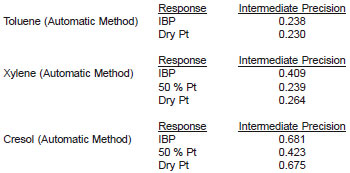ASTM D850 Standard Test Method for Distillation of Industrial Aromatic Hydrocarbons and Related Materials
12. Report
12.1 Report observed temperatures to the nearest 0.1°C, in a manner conforming to the specifications of the material tested. If no definite manner of reporting is specified, report the corrected temperatures at each observed volume, and report the volume percentages of residue, recovery, and distillation loss.
12.2 In the ASTM specifications where Test Method D850 is cited, the distillation range is defined as:
Distillation range, °C = DPT - IBP
where DPT is the dry point temperature and IBP is the initial boiling point.
12.3 In cases where decomposition points occur, the distillation range is defined as:
Distillation Range °C = DCPT - IBP
where:
DCPT = the temperature at the decomposition point, and
IBP = the initial boiling point.
13. Precision and Bias
13.1 Precision: Manual Distillation Method - The following criteria should be used for judging the acceptability of results (95 % confidence) on distillation determined by the manual method:
13.1.1 Intermediate Precision - Duplicate results by the same operator should be considered suspect if they differ by more than the following amounts:
Cyclohexane: 0.17°C
Benzene: 0.16°C
Toluene: 0.23°C
Xylene: 0.26°C
13.1.2 Reproducibility - Results submitted by each of two laboratories should be considered suspect if the two results differ by more than the following amounts:
Benzene: 0.42°C
Toluene: 0.47°C
Xylene: 0.42°C
NOTE 4 - There was insufficient data for cyclohexane to determine reproducibility.
13.2 Precision: Automatic Distillation Method - The following criteria should be used for judging the acceptability of results (95 % confidence) on distillation range determined by the automatic method. The precision criteria was derived from the interlaboratory data submitted by nine different laboratories. Each sample was run twice in two days by two different operators. Results were analyzed in accordance with Practice E 691.
13.2.1 Intermediate Precision - Duplicate tests by the same operator should be considered suspect if they differ by more than the following amounts:

NOTE 5 - Cresol data was analyzed with ANOVA (due to insufficient data to analyze with Practice E 691).
13.2.2 Reproducibility - Results submitted by each of two laboratories should be considered suspect if the two results differ by more than the following amounts:

NOTE 6 - There was insufficient data for cresol to determine reproducibility.
13.3 Bias: Manual and Automatic Distillation Methods - There was no significant bias found between data for this test method, as none of the T values for toluene or mixed xylene are significant at the 95 % confidence level.
NOTE 7 - For this test method, automatic distillation data are based on automatic distillation apparatus (ADA) with dry point sensors. The precision and bias statements for this test method are therefore only valid for ADA units with dry point sensing devices.
14. Quality Control
14.1 It is recommended that a material with a known distillation range of approximately 1.0°C be used when replacing a temperature measuring device. Alternatively a material of known distillation range and dry point may be used when replacing a temperature measuring device. This same material may be used for QC/QA testing.
14.2 Alternatively, when QC/QA protocols and materials are already established in the testing facility, these may be used.
15. Keywords
15.1 aromatic hydrocarbons; distillation



